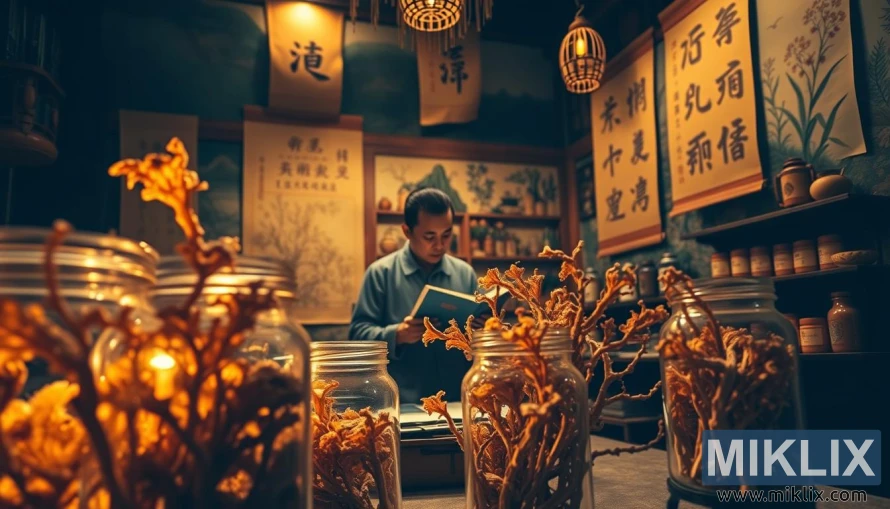Image: Cordyceps in Traditional Medicine
Published: July 1, 2025 at 9:59:19 AM UTC
Last updated: September 26, 2025 at 5:18:35 PM UTC
A warm, dimly lit study with cordyceps jars, a scholar reading ancient texts, and a mural of herbal apothecary, honoring Eastern wellness traditions.
The scene unfolds in a space that feels suspended between past and present, a traditional study steeped in the wisdom of Eastern medicine yet rendered with cinematic clarity that makes every detail feel alive. In the foreground, glass jars brimming with dried cordyceps fungi dominate the composition. Their twisted, coral-like forms branch outward in complex, organic patterns, their silhouettes etched sharply against the soft amber glow of the room’s lighting. These specimens, preserved with care, evoke both a sense of scientific study and sacred ritual, their very presence a reminder of the fungi’s longstanding role in traditional Chinese medicine. The light refracting through the jars adds a golden warmth that amplifies their vitality, as if the essence of the cordyceps continues to radiate life even in their dried state.
Moving into the middle ground, the eye rests on a solitary scholar, absorbed in the careful study of an ancient text. His posture, slightly hunched yet purposeful, conveys deep concentration and reverence. He seems less a modern researcher than a custodian of centuries-old knowledge, tracing the lineage of medicinal practice that has connected countless generations. The tome he studies, heavy with age, may well contain handwritten passages recording the therapeutic virtues of cordyceps, noting their reputed effects on stamina, vitality, respiratory health, and overall well-being. The scholar’s presence anchors the image, linking the preserved fungi of the foreground with the storied traditions of the background, embodying the role of human curiosity and dedication in keeping ancient wisdom alive.
Behind him, the background immerses the viewer in a rich tapestry of cultural symbolism. Hanging silk scrolls, inscribed with flowing calligraphy, dangle from the ceiling, their characters glowing softly in the lamplight. The writings themselves, though not immediately legible, emanate an aura of authority and tradition, as though carrying blessings or wisdom passed down through centuries. Along the walls, murals depict flourishing plants and medicinal herbs, echoing the holistic worldview of Chinese apothecaries where each botanical was seen not just as a treatment but as part of a balanced ecosystem of health. Wooden shelves lined with clay jars and canisters complete the setting, their labels hinting at an archive of exotic botanicals gathered from far and wide.
The lighting of the room is integral to the mood, diffused through paper lanterns and shaded lamps to create a warm, contemplative atmosphere. Shadows stretch softly across the surfaces, adding depth and texture without diminishing clarity. The interplay of light and shadow suggests both mystery and revelation, echoing the dual nature of traditional medicine—rooted in empirical observation yet tinged with spiritual reverence. Every element of the scene, from the golden glow of the cordyceps jars to the muted earth tones of the study, works together to immerse the viewer in an environment where knowledge is cherished as much as the substances themselves.
The composition as a whole is cinematic in its balance and scope, drawing the viewer into a moment that feels timeless. The jars of cordyceps at the front symbolize tangible evidence of nature’s gifts, while the scholar embodies the intellectual and spiritual labor of interpreting their significance. The murals and scrolls in the background extend the narrative into the realm of culture and tradition, reminding us that wellness in Eastern practice has always been about more than just the physical body—it encompasses harmony, balance, and respect for the interconnectedness of life.
Ultimately, the image captures the enduring legacy of cordyceps within holistic Eastern wellness practices. It is not merely a depiction of a study or a laboratory, but an invocation of continuity: the unbroken chain of knowledge that stretches from ancient herbalists to modern practitioners. By weaving together objects, symbols, and atmosphere, the scene tells a story of reverence for both nature and wisdom, where each jar of cordyceps stands as both medicine and metaphor—a vessel of vitality, tradition, and timeless healing.
The image is related to: From Fungus to Fuel: How Cordyceps Can Boost Your Body and Mind

